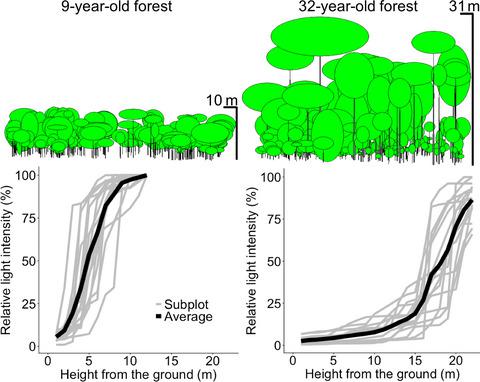Our official English website, www.x-mol.net, welcomes your feedback! (Note: you will need to create a separate account there.)
Forest structure drives changes in light heterogeneity during tropical secondary forest succession
Journal of Ecology ( IF 5.5 ) Pub Date : 2021-04-30 , DOI: 10.1111/1365-2745.13680 Tomonari Matsuo 1 , Miguel Martínez-Ramos 2 , Frans Bongers 1 , Masha T van der Sande 1 , Lourens Poorter 1
中文翻译:

热带次生林演替过程中森林结构驱动光异质性变化
更新日期:2021-04-30
Journal of Ecology ( IF 5.5 ) Pub Date : 2021-04-30 , DOI: 10.1111/1365-2745.13680 Tomonari Matsuo 1 , Miguel Martínez-Ramos 2 , Frans Bongers 1 , Masha T van der Sande 1 , Lourens Poorter 1
Affiliation

|
- Light is a key resource for tree performance and hence, tree species partition spatial and temporal gradients in light availability. Although light distribution drives tree performance and species replacement during secondary forest succession, we yet lack understanding how light distribution changes with tropical forest development.
- This study aims to evaluate how changes in forest structure lead to changes in vertical and horizontal light heterogeneity during tropical forest succession.
- We described successional patterns in light using a chronosequence approach in which we compared 14 Mexican secondary forest stands that differ in age (8–32 years) since agricultural abandonment. For each stand, we measured vertical light profiles in 16 grid cells, and structural parameters (diameter at breast height, height and crown dimensions) for each tree.
- During succession, we found a rapid increase in stand size (basal area, crown area and length) and stand differentiation (i.e. a gradual leaf distribution along the forest profile), which leads to fast changes in light conditions and more light heterogeneity. The inflection points of the vertical light gradient (i.e. the absolute height at which 50% relative light intensity is attained) rapidly moved towards higher heights in the first 20 years, indicating that larger amounts of light are intercepted by canopy trees. Light attenuation rate (i.e. the rate of light extinction) decreased during succession due to slower accumulation of the crown area with height. Understorey light intensity and heterogeneity slightly decreased during succession because of an increase in crown size and a decrease in lateral gap frequency. Understorey relative light intensity was 1.56% at 32 years after abandonment.
- Synthesis. During succession, light conditions changed linearly, which should lead to a continuous and constant replacement of species. Especially in later successional stages, stronger vertical light gradients can limit the regeneration of light-demanding pioneer species and increase the proportion of shade-tolerant late-successional species under the canopy. These changes in light conditions were largely driven by the successional changes in forest structure, as basal area strongly determined the height where most light is absorbed, whereas crown area, and to a lesser extent crown length, determined light distribution.
中文翻译:

热带次生林演替过程中森林结构驱动光异质性变化
- 光是树木性能的关键资源,因此,树种在光可用性方面划分空间和时间梯度。尽管光分布在次生林演替过程中驱动了树木性能和物种更替,但我们仍然缺乏对光分布如何随着热带森林发展而变化的了解。
- 本研究旨在评估热带森林演替过程中森林结构的变化如何导致垂直和水平光异质性的变化。
- 我们使用时间序列方法来描述演替模式,在该方法中,我们比较了自农业废弃以来年龄(8-32 年)不同的 14 个墨西哥次生林。对于每个林分,我们测量了 16 个网格单元中的垂直光剖面,以及每棵树的结构参数(胸高直径、高度和树冠尺寸)。
- 在演替过程中,我们发现林分大小(基面积、树冠面积和长度)和林分分化(即沿森林剖面逐渐分布的叶子)迅速增加,这导致光照条件的快速变化和更多的光照异质性。垂直光梯度的拐点(即达到 50% 相对光强度的绝对高度)在前 20 年迅速向更高的高度移动,表明更多的光被树冠拦截。由于冠部面积随高度累积较慢,因此在演替过程中光衰减率(即光消光率)下降。由于树冠尺寸的增加和横向间隙频率的降低,在演替过程中,下层光照强度和异质性略有下降。
- 合成。在演替过程中,光照条件呈线性变化,这将导致物种的连续不断的更替。特别是在演替后期,较强的垂直光照梯度可以限制需光先锋树种的更新,增加树冠下耐阴后期演替树种的比例。光照条件的这些变化主要是由森林结构的连续变化驱动的,因为基底面积强烈决定了吸收大部分光的高度,而树冠面积和较小程度的树冠长度决定了光分布。


























 京公网安备 11010802027423号
京公网安备 11010802027423号